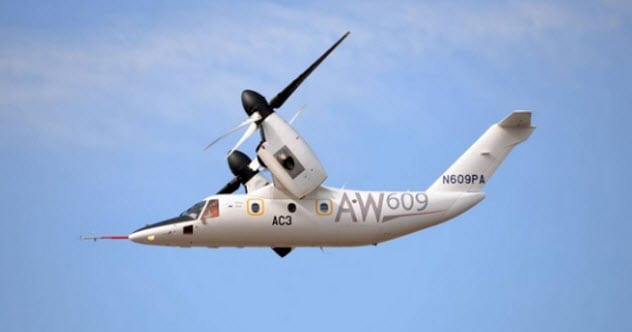 Animals
Animals  Animals
Animals  Weird Stuff
Weird Stuff 10 Weird Things People Used to Do at New Year’s
 Our World
Our World 10 Archaeological Discoveries of 2025 That Refined History
 Weird Stuff
Weird Stuff 10 Fascinating Facts You Might Not Know About Snow
 Miscellaneous
Miscellaneous Top 10 Things Crypto Was Supposed to Change & What Actually Did
 History
History 10 Huge Historical Events That Happened on Christmas Eve
 Music
Music 10 Surprising Origin Stories of Your Favorite Holiday Songs
 History
History 10 Less Than Jolly Events That Occurred on December 25
 Weird Stuff
Weird Stuff 10 Funny Ways That Researchers Overthink Christmas
 Politics
Politics 10 Political Scandals That Sent Crowds Into the Streets
 Animals
Animals 10 Species That Refused to Go Extinct
 Weird Stuff
Weird Stuff 10 Weird Things People Used to Do at New Year’s
 Our World
Our World 10 Archaeological Discoveries of 2025 That Refined History
Who's Behind Listverse?

Jamie Frater
Head Editor
Jamie founded Listverse due to an insatiable desire to share fascinating, obscure, and bizarre facts. He has been a guest speaker on numerous national radio and television stations and is a five time published author.
More About Us Weird Stuff
Weird Stuff 10 Fascinating Facts You Might Not Know About Snow
 Miscellaneous
Miscellaneous Top 10 Things Crypto Was Supposed to Change & What Actually Did
 History
History 10 Huge Historical Events That Happened on Christmas Eve
 Music
Music 10 Surprising Origin Stories of Your Favorite Holiday Songs
 History
History 10 Less Than Jolly Events That Occurred on December 25
 Weird Stuff
Weird Stuff 10 Funny Ways That Researchers Overthink Christmas
 Politics
Politics 10 Political Scandals That Sent Crowds Into the Streets
10 Futuristic Technologies Of ‘Avatar’ That We Already Have
After almost a decade, James Cameron’s Avatar has become a must-see film for any movie lover. Being the highest-grossing movie of all time and winner of three Oscars, the success of Avatar allowed it to have four more sequels coming over the next few years. Beyond its revolutionary technical aspects, the film generated a popular interest for the amazing technological and natural elements that are described in the history of two worlds: the Earth and Pandora.
The story of the film takes place in the year 2154. The Earth is overcrowded with indifferent and greedy people, and we begin to look for solutions to our problems in other places in the universe. During the course of the movie, we witness the immense technological advances that humans have achieved—machines and devices that we have only seen in sci-fi works for a long time.
However, the incredible part is that even when the plot takes place within a century and a half, we already have many of those advances. Some time ago, we showed you the real equivalent of Pandora’s life-forms on our own planet. So now it is time to see that much of the futuristic technology of the film is already within our reach. In fact, the future of Avatar may be much closer to our present than we could imagine.
10 Exopack (Oxygen-Filtering Device)

Scientific details in the plot of Avatar state that Pandora’s atmosphere contains large amounts of carbon dioxide and hydrogen sulfide. For this reason, if a human breathes naturally in that atmosphere, he will die intoxicated in a few minutes.
So humans in Pandora need to use a device called “exopack.” This equipment consists of a breathing mask connected to a mechanism that filters oxygen from the air while eliminating toxic gases. Thus, the person using the exopack can breathe fresh air without the need to carry oxygen tanks.
The truth is that this technology already exists, and we have devices capable of constantly filtering the air from other substances to breathe it. The creator of this technology is the Israeli company Like-A-Fish Technologies, founded in 2001.
Traditional diving suits have oxygen tanks that need to be recharged after some time. So Like-A-Fish Technologies created an underwater breathing system without tanks, which directly extracts the air dispersed in the seawater. Such air represents 2 percent of the total volume of the water body, so the device works continuously for as long as its batteries last.
The creators of the project have already thought about expanding the uses of this promising technology—for example, to provide breathable air in hermetic environments. With a little more development, we could make this device become a full-fledged exopack.[1]
9 Giant Robotic Vehicles
To perform mining operations on Pandora, Avatar describes that humans use unmanned vehicles with the height of a small building and remotely controlled by an operator. From excavators to dump trucks, these vehicles are very similar to the huge mining trucks currently used in large mines.
The difference is that the most advanced mining vehicles of our time still do not reach the full level of automation of the machines in the movie. They even have cabins for drivers if an eventuality arises. Well, it was like that until recently, but we have finally built vehicles—both gigantic and unmanned—that are similar to those in James Cameron’s movie.
Since 2008, Japanese company Komatsu has been commercializing a system of autonomous mining trucks which have already carried millions of tons of material in places like Australia and Chile. However, in 2016, the company presented a prototype of haul truck both autonomous and cabless, just like the mining vehicles in Avatar. The truck is fully electric, and an operator can drive it using wireless controls.[2]
But the resemblance to the machines of the movie does not end there. Komatsu’s remotely controlled truck also has a monstrous size, with its 15 meters (49 ft) in length and load capacity of 230 tons. Although the launch date of this truck has not been fixed, Komatsu says it plans to commercialize it “in the near future.” Then we can take it to a distant moon to load it with rocks.
8 Transparent Displays
From televisions to ads, including monitors and tablets, almost all communication devices displayed in Avatar have fully transparent screens. The idea of having transparent TVs or cell phones has been the dream of many people for decades. It is even believed to be the previous step to more advanced technologies such as midair holograms.
For a long time, science struggled to create such devices, capable of projecting clear images when necessary but being crystalline like glass at the same time. And after many attempts, it finally seems that it has been achieved.
Traditional displays such as LEDs and LCDs generate images using something called backlight, which in essence is a bright, white screen on the back of the device. The light it emits then passes through small crystals on the front of the display that filter the light according to the color needed to form the image.
Therefore, common digital screens are dark and opaque. They need the backlight screen to emit the image you see. However, we then created the so-called organic LEDs (OLEDs). An OLED screen is made up of millions of small diodes, each of which emits its own light. So, in this case, the backlight is no longer necessary and an OLED screen no longer needs to be opaque.
The technology of transparent OLEDs has been around for several years with sizes ranging from a window to a cell phone screen. In recent times, the most recognized companies in the sector began to publicly present their own transparent displays.[3]
Nevertheless, something even more revolutionary is the technology of transparent touch screens. In 2016, a company called TechRobotix presented a transparent 140-centimeter (55 in) touch screen and the result is as futuristic as what Avatar could show you.
7 Advanced Rotorcraft

A tilt-rotor aircraft has propeller engines capable of rotating their positions independently of the rest of the vehicle. Thus, this aircraft is able to take off vertically like a helicopter, tilt its rotors, and advance like an airplane.
For this reason, tilt-rotor aircraft are faster than a conventional helicopter as the speed of the latter is limited by the angle of inclination of the entire vehicle. In Avatar, the military in Pandora use tilt-rotor vehicles called Scorpion, twin-turbine aircraft both fast and agile.
The official story of the movie says that Scorpion Gunships were created in the mid-21st century, almost a century before the events in Pandora. For that reason, these vehicles are among the least advanced technology of the 2009 film and we already have similar aircraft in operation.
Although such vehicles are still inferior to those of Avatar in technology and performance, we have created tilt-rotor prototypes in recent times that are capable of competing even with a sci-fi aircraft. Let’s see, for example, the case of the Italian company AgustaWestland, which in 2013 officially presented a tilt-rotor aircraft called Project Zero.[4]
The “Project Zero” vehicle is fully electric and is powered by two propeller turbines, which can tilt more than 90 degrees. These turbines allow the vehicle to take off vertically and hover in the air. In cruise mode, the aircraft glides with its wings and the propellers themselves can function as wind turbines to recharge the batteries.
Its futuristic design is unlike any other operational aircraft, and the creators of the project state that this vehicle could be used in missions on Mars. Curious fact: Another aircraft of the movie, the four-turbine “Dragon” gunship, has a great resemblance to an American experimental vehicle, the Bell X-22, developed in 1966.
6 Levitation Device
If you try to put a magnet on top of another to see if it floats, you will see that it is impossible. No matter how hard you try, the magnetic fields of inert objects make them unable to align. So the magnets attract or repel each other.
However, in Avatar, we can see how one of the characters in the movie plays with a piece of metal floating on a magnetic levitation device. The key is that this piece of metal is the precious “unobtanium,” a hypothetical superconducting metal and, of course, the MacGuffin of the movie. This is where real physics comes into play, and the phenomenon seen in the film becomes plausible even for us.
Unlike other conventional metals, a superconductor is a metal that conducts electricity without any resistance. Currently, all known superconductors must be frozen at very low temperatures to function as such.
However, the unobtanium of Avatar is a room-temperature superconductor, which in reality would be something like the Holy Grail for science. It happens that if you place a magnet on a frozen superconducting metal, the magnet will float without problems and will remain stable.[5]
This is called superconducting levitation and is currently an experiment repeated many times in laboratories around the world. So the levitation device you see in Avatar is nothing more than a fancy magnet lifting a superexpensive metal.
But what if the object you want to lift is not magnetic or metallic?
Do not worry because scientists from the United Kingdom created a device capable of levitating all kinds of objects by sound waves. The so-called “sonic tractor beam” is generated by multiple mini-speakers that emit ultrasonic waves.
If an object is placed at the point of intersection of these waves, it will float inert in the air. So we still do not find unobtanium, yet we can make things fly in the meantime.
5 Laryngophones

While on the battlefield, several characters of the movie use a special communication device attached to their throats called Aircom Headset. When they press this device, they can remotely communicate with each other.
In reality, we call this device “throat microphone” or laryngophone. In environments where there is a lot of background noise, conventional microphones cannot properly capture the person’s voice as these receive any sound wave that travels through the air.
Instead, throat microphones consist of one or more sound receivers placed directly on the larynx of the person so that these microphones capture only the vibrations the person produces when speaking. When using laryngophones, no other external sound interferes with communication.
Throat microphones are certainly a technology we have had for a long time. In fact, the invention of these devices dates back to the 1930s when they were incorporated into flight suits. Later, the Nazis used them during World War II.
Nowadays, many military and security forces in the world use laryngophones to communicate in extreme conditions. Of course, not all of these devices have lightweight and advanced designs like those of Avatar.
For example, we can see an advanced throat microphone created by the company iASUS Concepts. This microphone has a compact and ergonomic design. The most notable thing is that it completely cancels the ambient noise without losing the quality of the person’s voice.[6]
The laryngophone is one of the technologies of Avatar that we have best developed to date, but it is no less impressive.
4 Giant Manned Robots

Undoubtedly, AMP Suits are among the most iconic technologies of Avatar. These advanced vehicles are giant manned robots driven by soldiers to use heavy weapons and carry large objects. Being 4 meters (13 ft) tall, an AMP Suit can handle weapons such as handheld cannons, flamethrowers, and giant knives.
It is understandable that we do not believe this type of machine exists today. We usually do not see a giant robot walking down the street. But incredibly, science has already created the AMP Suit and the result seems straight out of a high-budget movie.
In 2014, South Korean company Hankook Mirae began working on a prototype of a giant bipedal robot called Method, which would be controlled from the inside by an operator. In early 2017, a more advanced version of the robot, Method-2, was publicly presented.
The Method-2 is a manned robot measuring 4 meters (13 ft) tall, just like its counterpart from Avatar. With a weight of 1.6 tons and a cost of $100 million, the design of the Method-2 is very similar to that of an AMP Suit. This is because its designer is a concept artist who also worked on high-budget films such as Transformers. The arms of the pilot inside the robot are connected to mechanisms that move the limbs of the machine in real time.
For now, the movements of the legs are remotely controlled by other operators. But that could change in the near future as Hankook Mirae plans to release updated and more futuristic versions of the robot.[7]
According to the company itself, future uses of the Method robot will range from rescue missions to military operations. It has even been proposed that these robots could be used to patrol the border between the two Koreas.
3 Handheld Super-Flamethrower

Flamethrowers have been widely used over time by civilians and the military. The Nazis used them, Russians used them, even farmers used them. According to Avatar, soldiers on other planets will also continue to use them. In the final battle of the movie, human soldiers use powerful flamethrowers to make their way through the dense jungle of Pandora.
These super-flamethrowers are capable of covering great distances with their scorching jets of flame. The best part is that they are portable. Pressurized fuel is stored directly inside the lightweight casing of the device, so it is not necessary to carry extra fuel tanks like a conventional flamethrower. If this technology seems a bit advanced for our time, well, we already have it, too.
Let’s first consider the famous flamethrower of The Boring Company launched earlier this year. Although it has a fancy design close to that of Avatar flamethrowers, its range of fire is so limited that it does not exceed 3 meters (10 ft). For this reason, it is often more compared to a propane torch than to a flamethrower.
So let’s move on to a stronger version. An American company managed to develop an advanced handheld device called the XM42-M flamethrower. This portable flamethrower has an aluminum body and is powered by liquid fuel, thus avoiding the use of gas tanks. The powerful device has a range of more than 9 meters (30 ft) with a simple but practical design that can be equipped with laser sights.[8]
The most interesting thing is that both flamethrowers are commercial products created for civilian use. In fact, flamethrowers are generally prohibited for military use. So, if Pandora really exists, it should be more worried about civilians with flamethrowers than about soldiers.
2 Suborbital Aircraft

The film shows that after arriving at Pandora, humans descend from their orbiting interstellar spacecraft to the Moon’s surface by using a suborbital vehicle called Valkyrie. This aircraft has the ability to fly into outer space and reenter the atmosphere in one piece.
Although our classic space shuttles look similar to the Valkyrie, the former relied on external rockets and single-use parts to propel themselves into space. Instead, the Valkyrie propels by itself.
This does not mean that we do not have the technology of suborbital aircraft. In fact, we can mention several types of vehicles specially created to go to space and return just as the Valkyrie would do it.
As early as 1959, the United States Air Force developed the X-15, an experimental aircraft capable of suborbital flights. During its 199 test flights, the X-15 reached a flight height of almost 108 kilometers (67 mi). Beyond 100 kilometers (62 mi), it was already in outer space. After that, the spacecraft could glide and land without difficulty.
Several decades later, in 2004, another vehicle called SpaceShipOne achieved the same results. A special plane took SpaceShipOne up to 15 kilometers (9 mi) high after which both vehicles separated. From there, the spaceplane continued to climb by itself all the way up to more than 100 kilometers (62 mi), thanks to its rocket engine.[9]
Its landing process was similar to that of the X-15. As an interesting detail, another plane called Boeing X-20 had the same suborbital capabilities of the aforementioned vehicles. Although this project was canceled in 1963 just before completing the first prototype, its design was going to be very similar to the Valkyrie from Avatar.
1 De-Extinction Technology

At the beginning of the film, while we are still on Earth, we can see a newscast of the future projected on a wall. In the newscast, it is stated that Bengal tigers have been revived by cloning after being extinct for a century. This process is real and is known as de-extinction, the recovery of an extinct species by cloning its individuals through another near relative species.
De-extinction is a very complex process because it involves using cells of the extinct being to artificially fertilize a near relative with them. It is an advanced and very expensive technique. But in our century, we have made great progress in this field. Moreover, we have already brought extinct species back to life.
In 2003, a Spanish-French scientific team revived a type of wild goat called bucardo whose species had become extinct three years earlier. By implanting the cell nucleus of a bucardo into an empty goat egg, scientists were able to artificially fertilize the latter.
After some time, the first cloned bucardo was born, thus representing the first extinct species revived by cloning. Sadly, the bucardo died a few minutes after birth due to a lung failure.[10]
All this happened a decade and a half ago. But now, with more advanced knowledge in cloning and genetic engineering, scientists believe that de-extinction is already completely viable. According to a report, we can finally bring back mammoths in the next few years.
What is missing now to revive more extinct species is not technology but financial support. With the reduced interest of the authorities in de-extinction, the most promising way of economic support for this technology would be tourist parks with cloned specimens of extinct species.
Brian is an economy student who is passionate about graphic design. He is also an avid enthusiast of the art of writing.
Read about more fictional technologies that we already have on 10 Fictional Technologies You Didn’t Know Existed and 10 Cool Sci-Fi Technologies Invading Our Reality.








